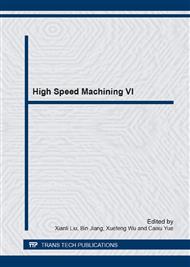p.390
p.394
p.398
p.402
p.408
p.417
p.424
p.430
p.435
Modal Analysis of High-Speed Face Milling System Based on Composite Structure System Analysis Method
Abstract:
This paper adopts composite structure system analysis method to perform modal analysis of high-speed face milling cutter which is mounted on the machine tool through FEM modal analysis. The key problem of this method is to obtain joint surface parameters between the machine tool spindle and face milling cutter through experimental modal analysis and MATLAB software. The joint surface parameters consist of linear stiffness, linear damping, rotation stiffness and rotation damping. After getting the frequency response function (FRF) at the tool tip of the face milling system through experimental modal analysis, the contact surface parameters can be used to eliminate the influence of the machine tool to get modal parameters of the face-milling cutter itself. Based on the finite element model of face milling cutter, composite structure system analysis method can be used easily to acquire the dynamic performance of the face milling system through FEM modal analysis, greatly to improve the reliability of modal analysis, and is helpful to the dynamic design and the structure improvement of high speed face milling cutter.
Info:
Periodical:
Pages:
408-413
Citation:
Online since:
July 2014
Authors:
Price:
Сopyright:
© 2014 Trans Tech Publications Ltd. All Rights Reserved
Share:
Citation:


